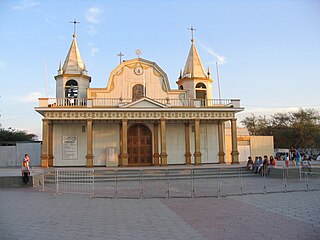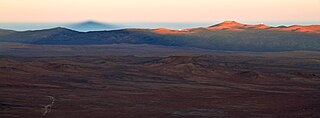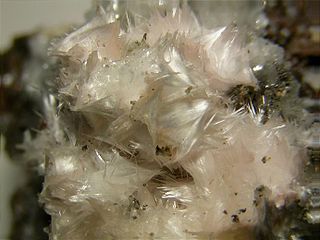Pampa or La Pampa may refer to:
Luis Advis Vitaglich was a Chilean professor of philosophy, and a noted composer of traditional and New Chilean music. He was officially recognized as a fundamental figures of Chilean music in 2003.

La Tirana is a Chilean town in the commune of Pozo Almonte in El Tamarugal Province, Tarapacá Region. The town lies in an oasis in the middle of the Pampa del Tamarugal, about 72 km inland from the port of Iquique.
The Central Valley, Intermediate Depression, or Longitudinal Valley is the depression between the Chilean Coastal Range and the Andes Mountains. The Chilean Central Valley extends from the border with Peru to Puerto Montt in southern Chile, with a notable interruption at Norte Chico. South of Puerto Montt the valley has a continuation as a series of marine basins up to the isthmus of Ofqui. Some of Chile's most populous cities lie within the valley including Santiago, Temuco, Rancagua, Talca and Chillán.

Prosopis tamarugo, commonly known as the tamarugo, is a species of flowering tree in the pea family, Fabaceae, subfamilia Mimosoideae. It is only found in northern Chile, particularly in the Pampa del Tamarugal, some 70 km (43 mi) east of the city of Iquique. This bushy tree apparently grows without the benefit of rainfall, and it is thought obtains some water from dew. Studies indicate it is a Phreatophyte ; having deep roots that tap into ground water supplies. It also participates in hydraulic redistribution moving water from deeper levels to the upper and also reversing the process in times of severe drought.

Pampa del Tamarugal is a vast plain encompassing a significant portion of the Norte Grande, Chile, and originally named for the Prosopis tamarugo trees that used to cover its surface. It is located between the parallels 19°30’ and 22°15’ south latitude and is considered part of the Atacama Desert. It is bounded on the west by the Chilean Coastal Range and on the east by the western slopes of the Andes. The plain occupies a surface area of 12,500 km2 with an average elevation of 1100 m.

Pampa del Tamarugal National Reserve is a nature reserve of northern Chile's Tarapacá Region located in the Pampa del Tamarugal, about 70 km (43 mi) east of Iquique. The reserve consists of three separate sectors: Zapiga, Bosque Nativo de La Tirana, and Pintados. The major highlights are the artificially planted forests of the genus Prosopis, found in the middle of a rainless desert, and the Pintados geoglyphs.

Tamarugal Province is one of two provinces in the northern Chilean region of Tarapacá. The capital is the city of Pozo Almonte.

The Cordillera Vicuña Mackenna is the highest section of the Chilean Coast Range located in northern Chile, west of Pampa del Tamarugal. Its peak reaches over 3000 meters. It runs north-south for approximately 170 km parallel to the Andes. The driest parts of Atacama Desert are located east of the range due to the rain shadow produced by it.

Pickeringite is a magnesium aluminium sulfate mineral with formula MgAl2(SO4)4·22(H2O). It forms a series with halotrichite.
Eupithecia landryi is a moth in the family Geometridae. It is found in the coastal valleys of the northern desert of Chile.
Eupithecia yubitzae is a moth in the family Geometridae. It is found in the valleys of northern Chile: the Azapa, Chaca and Camarones valleys.
Eupithecia robinsoni is a moth in the family Geometridae. It is found on the Juan Fernández Islands in Chile.
Eupithecia elbuta is a moth in the family Geometridae. It is found in Chile and/or Peru.
Eupithecia chilensis is a moth in the family Geometridae. It is found in Chile.

Pica Aquifer located in Tarapacá Region of northern Chile is one of the most important aquifers of Atacama Desert. The water of the aquifer is tapped by a system of underground aqueducts known as puquios to irrigate the oases of Pica and Matilla. The uppermost part of the aquifer is within loosely consolidated alluvial and aeolian sediments deposited in the Quaternary period. The recharge zone of Pica Aquifer is estimated to lie between ~3,000 and 4,000 meters above sea level.
Puquio de Núñez is a small oasis and orchard in the Atacama Desert of Chile. The oasis is irrigated by an underground canal, a puquio tapping Pampa del Tamarugal Aquifer. Puqui de Núñez lies about 10 kilometers south of the nearby oases of Matilla and Pica. As the puquios of Pica and Matilla tap the Pica Aquifer, it is thought that the hydraulic divide between the aquifers of Pampa del Tamarugal and Pica should be between Puquio de Núñez and Matilla.

Pampa del Tamarugal Aquifer located in Tarapacá Region of northern Chile is one of the most important aquifers of Atacama Desert.
The paradas method was a process to extract nitrate from caliche by leaching. In this method caliche was boiled in water in large pans called "paradas". It was a firewood and labour-intensive process. The paradas method was phased out in the 1850s by a new system invented by Pedro Gamboni which required less fuel and labour.

Calatambo Albarracín, born Freddy Albarracín Iribarren, was a Chilean composer and folklorist identified with the music of northern Chile.







